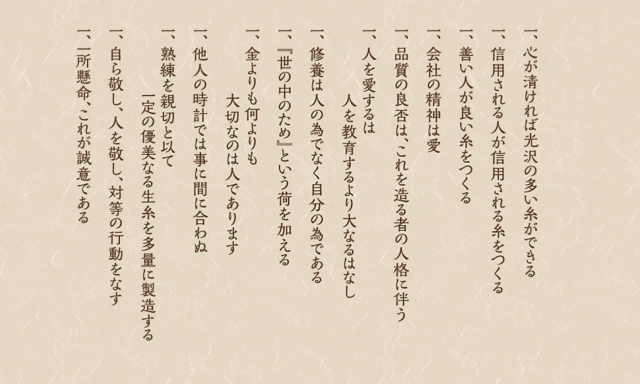Realizing Co-existence and Sustainable Management at Gunze Museum
Discussions about women’s empowerment and sustainability are very common nowadays, but did you know there was a company that devoted itself to women’s empowerment and regional development more than 100 years ago? The company is Gunze, a well-known manufacturer of innerwear and legwear. In this article, we will take a look at Gunze Museum. Gunze protected silk farmers in poor areas, especially women, by improving the techniques used in manufacturing silk and by providing them with education. The company aimed to promote sustainable management and “co-existence and co-prosperity” with all their business partners. Gunze Museum sheds some light on where the company is going and what developments they have in store for the future, right from where it was founded.
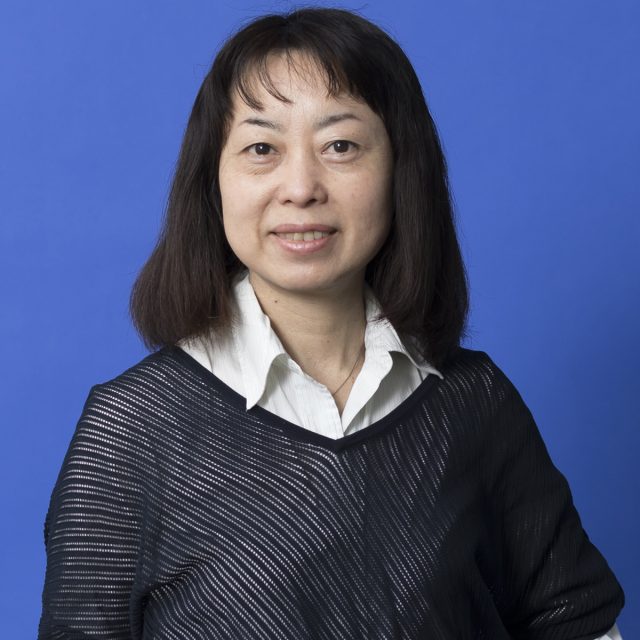
Akemi Sakurai, PR Consulting Dentsu Inc.
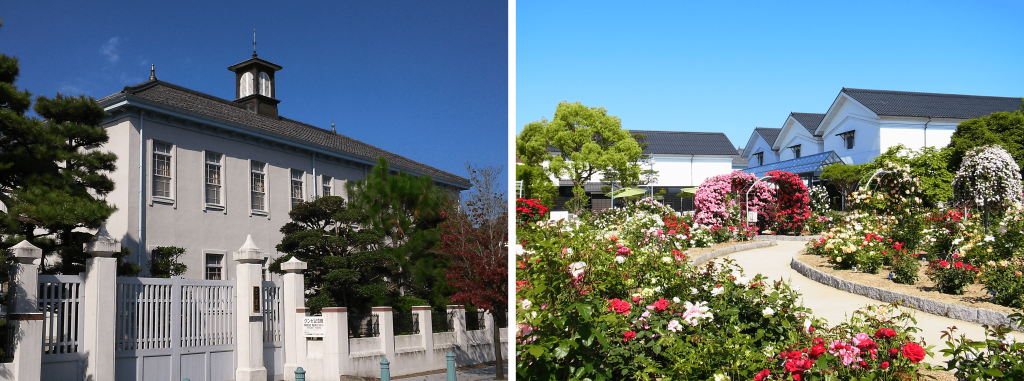
(Left) Gunze Commemoration Hall (right), the Gunze Museum (Photo courtesy of Gunze)
Close cooperation between Gunze Museum and Ayabe City
Ayabe City is a rural city located in the northern part of Kyoto with a population of about 30,000. The Yuragawa River water system provides for the city. Opened in 2014, Ayabe Gunze Square is a place for tourists to mingle with the locals and is a 10-minute walk from JR Ayabe Station. It covers 8,257 square meters and is jointly operated by Gunze and the Ayabe Chamber of Commerce and Industry. It is here that Gunze Museum is located, along with the Ayabe Rose Garden (Ayabe Rose Association Operation Committee), and Ayabe Tokusankan (managed and operated by the Ayabe Chamber of Commerce and Industry).
Although Gunze’s head office is located in Osaka, Gunze Museum was founded in Ayabe in 1996 to commemorate the 100th anniversary of Gunze’s founding, as well as to help revitalize the region and utilize the historical buildings left there. Since then, the museum has been renovated twice, for the 110th and 120th anniversaries, and Ayabe Gunze Square was opened. This, along with the help of seasonal events, increased the number of museum visitors to 42,000 per year before COVID-19. The museum is used for training for new employees and executives, business partners, and shareholders Gunze Museum also hosts local elementary, junior high, and senior high school students from more than a dozen schools (12 schools in 2021) each year. Guided tours are available upon request.
The museum has the following buildings on its premises: Four cocoon storehouses, that is, Konjaku-gura, which introduces Gunze’s past and present by utilizing the original cocoon storehouses of the Taisho period as they are, and three consecutive exhibition storehouses, Sogyo-gura, Gendai-gura, and Mirai-gura. There is also Tsudoi-gura, which can be used as a meeting place, and Dokoan—a place for relaxation—which was the company residence for the founder, his wife, and employees. In addition, there is Gunze Commemoration Hall (open only on Fridays) adjacent to the company residence. This is a western-style building built in 1917 as the head office. If you look around all these buildings, you will see why the company is named Gunze—which means “the policy of the county.”
The area is designated as Heritage of Industrial Modernization of the Ministry of Economy, Trade and Industry. While Gunze strives to preserve the environment, Ayabe City aims to register it as a Kyoto Prefecture Landscape Asset and lay power lines underground and pave improved sidewalks in the surrounding towns. It is a perfect location for movies and dramas of the Meiji and Taisho periods. The movie “A Man Called Pirate,” the drama “Leaders,” modeled on Toyota Motor founder Kiichiro Toyoda, and the TV program “Maeda Masana – a Man who Entrusted by Ryoma,” which commemorated the 50th anniversary of the opening of Kagoshima TV Station, were filmed here. The dream of Gunze Museum and Ayabe City is to make the life history of the founder Tsurukichi Hatano and his wife Hana into an NHK morning TV drama. In 2015, the NHK Morning TV Drama Promotion Council was established and are currently focusing on invitation activities.
Co-existence as a key concept through a people-oriented approach and a commitment to quality
The key concept of Gunze Museum is to convey the founding spirit of Gunze, “Striving for harmonious co-existence with all stakeholders surrounding the company through a people-oriented approach and a commitment to quality,” through exhibited items and materials. During the interview, the head of the museum and my guide through the facility, Mr. Norito Takao, said that in addition to tracing the history, “I would like people to know that Gunze is working toward sustainable management that balances financial value and social value, and the realization of the SDGs 2030 vision.”
Through the items exhibited in Tenji-gura and the Commemoration Hall, it is easy to understand that the founder and his wife educated their female employees and worked hard to protect the interests of the silk farmers and their business partners. It is also clear that the company is working to develop sustainable products that reduce environmental impact and medical products that improve quality of life.
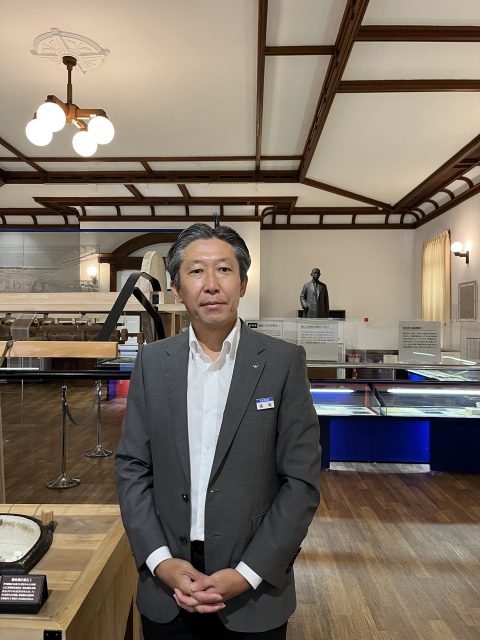
Mr. Norito Takao, Head of Gunze Museum (Photo taken by the writer)
Tsurukichi Hatano, the founder
Gunze Silk Manufacturing Co., Ltd., which was founded in 1896, used the Chinese character for “Gunze” until its name was changed in 1967. Gunze means the “policy of the county” (Ikaruga County at the time). The founder, Tsurukichi Hatano, was the second son of the Hamuro family, a major village leader, and was adopted by the Hatano family on his mother’s side at the age of eight. Hatano was deeply impressed by the lecture of Masana Maeda, a former Ministry of Agriculture and Commerce official who planned the policy for encouraging new industries of the Meiji government. Masana Maeda said in his lecture, “Our greatest need today is to establish national, prefectural, district, and village policy.” Hatano made a firm decision, believing that, “for the development of the county, the silk industry must be vitalized as a local industry,” and put all his efforts into establishing a company. He did not have ambitions of becoming an administrator. Rather, he was inspired to protect the interests of farmers. He had experienced disappointing events in his youth, and while working as a schoolteacher for several years in his twenties, he witnessed the unfair treatment and poor lives of silk farmers, which was the family business of many students.
Ten years before the company was established, Tsurukichi worked hard to establish Ikaruga-gun Silk Industry Association. He invited Masana Maeda to share new ideas with the local people and promote their understanding. However, it was not easy to move the farmers. Everyone kept what they knew to themselves and did not act for the benefit of other people. Finally, he thought, “I have to do it myself,” and decided to establish a company with the help of his wealthy parents. At the time of its establishment, he was particular about having each silk farmer become a “single share shareholder” for a small sum. The amount of the contribution was not important. Tsurukichi’s aim was to have each person participate in the management of the company and make it their own. In this way, he tried to create a good circulatory structure in which silk farmers and the company could work hard together.
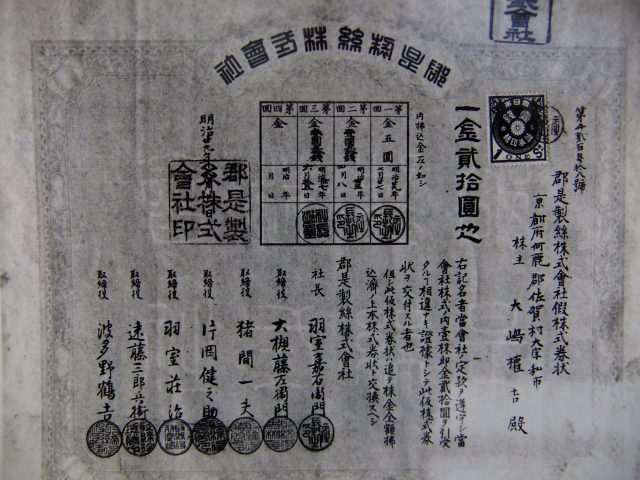
At the Gunze Commemoration Hall, the first temporary share certificate of 20 yen (a current value of about 700,000 yen) for a single share shareholder is on display. (Photo courtesy of Gunze)
Creating high-quality silk
The name of Ayabe City comes from Ayabe, where Ayahito, Chinese immigrants who worked to produce Ayaori (twilled silk textiles), lived. The place has long been known as a production area for silk and textiles. However, at the Zenkoku Kyoshinkai (the evaluation exhibition in Tokyo) held in 1885, silk products made in Kyoto were dishonorably judged to be of the lowest quality. Tsurukichi’s challenge was to create high-quality silk that was second to none. The work of silk farmers involves growing mulberry leaves—which are eaten by the silkworms—as well as raising silkworms and spinning silk threads from cocoons. It took a lot of effort and was known as “agriculture that no one wants to do if it is not necessary.”
On the other hand, raw Japanese silk was a major export at that time, bringing in about 60% of the country’s foreign currency. There was more than enough demand. At that time, silk farmers were exposed to bad practices such as prices being unilaterally determined by brokers, raw silk becoming a target of speculative investment, and being tossed at the mercy of price fluctuations. Tsurukichi worked to rectify these unreasonable problems. First, with regard to the fluctuating price of raw silk, the Market Price Contract in 1901 fixed prices on the 5th and 10th days of each month. Next, he introduced Quality Evaluation Purchasing in 1909. He signed sales contracts with farmers to ensure purchases according to the grade in advance and built partnerships so that farmers could make healthy efforts to improve quality. “Make both buyers and sellers happy,” he said. He aimed for sustainable corporate management and mutual development of society by building good relationships with employees and partners.
A mill on the outside, a school on the inside
One day, Tsurukichi heard from a company executive that a farmer who makes good silk has good family relationships. He thought it was important to foster a good family in order to produce good silk, and before that, it was important to have good people. Tsurukichi is also known as a devoted Christian who had no self-interests and strove to be frugal. He lived with his employees in a building called Dokoan, which was used as company housing.
Dokoan was moved to the Gunze Square premises and is preserved. He provided educational opportunities in the evenings to female employees—called “koujo” (female mill workers)—who worked during the day and educated them on topics including humanity. There was an education section in Gunze, and Shinsui Kawai, a Christian and educator, was in charge. In 1917, Hatano established the Gunze School for Female Employees, which was called the Bride School. A dressing mirror was presented to female mill workers after four years of service, and chest of drawers was presented after six years of service as a bride’s gift. Seeing these efforts, people said that this is “a mill on the outside but a school on the inside.”
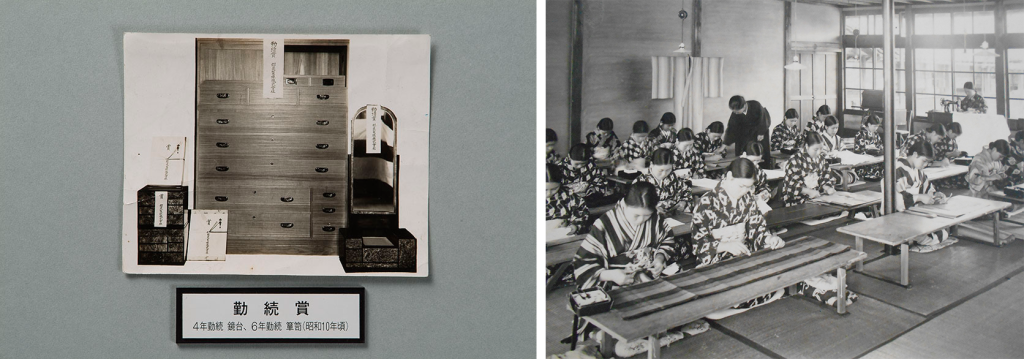
Photos of gifts presented at the time (left) and the morning assembly and sewing lessons (right) displayed in Memorial Hall (Photo courtesy of Gunze)
The founder's "beliefs" that overcame many difficulties
Tsurukichi’s personality, power of action, and beliefs saved the company from crises many times. One example is when employees voluntarily proposed reducing labor costs. In Gunze Commemoration Hall, requests from employees to lower their salaries to protect the company are displayed. Another example is when William Skinner and Sons Silk Manufacturing Company, a major American textile company, promised to procure Tsurukichi’s silk in bulk. William Skinner, the owner, personally came to Japan and met with Tsurukichi, deepening their trust in one another, and expanding business. In Memorial Hall and Sogyo-gura, raw silk trademarks for the Skinner and Sons Company are displayed.
Finally, the third example are the substantial unsecured loans from the company’s primary banks. When Gunze’s primary banks Meiryou Bank and Daihyakusanju Bank failed amid the financial crisis, Zenjiro Yasuda, founder of Yasuda Bank, was asked by the government to relieve Gunze of its debts. Yasuda was suspicious of Daihyakusanju Bank’s unsecured loans and visited Tsurukichi. When he arrived at the gate, he approached a man dressed in a simple kimono who was sweeping and asked him to notify Tsurukichi of his arrival. However, this was Tsurukichi Hatano. Yasuda instantly saw Tsurukichi’s conviction and continued financing the company. Yasuda’s trust in Tsurukichi was unwavering. It is said that when Gunze was struggling due to a fall in silk prices, Yasuda, who was in his sick bed, left a message to his people saying, “In case of an emergency, save Gunze.”
The Empress’ first visit to a private company
Four years after its founding, Gunze exhibited its products at the World Exposition in Paris and won the gold medal. The management’s commitment to high quality and the contributions to the community were recognized by the house of the Emperor, where the Empress herself had been cultivating silkworms. In 1917, 21 years after the founding of the company, Empress Teimei, visited the company—the first time the Empress visited a private company. It was a great honor to receive the Empress, and naturally it became a major event in the region. The roads were improved to accommodate the carriage procession. On the second floor of Gunze Commemoration Hall, Her majesty’s throne and the Japanese-style room for her attendants are preserved as they were. An incense burner depicting the life of silkworms, an imperial gift, and photographs are also displayed.
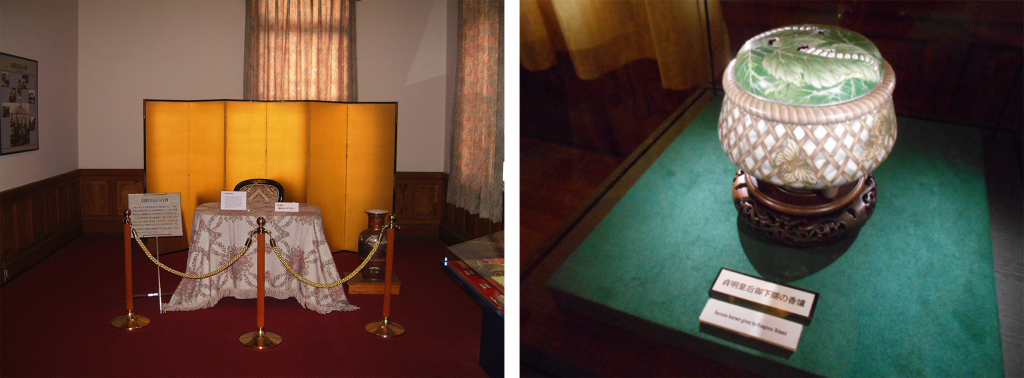
The throne (left), and an incense burner depicting the life of silkworms (right) (Photo courtesy of Gunze)
Transitioning to an apparel business - From raw silk to nylon and knitwear
In 1934, production of full-fashion socks led Gunze to transform itself into an apparel company. As raw material costs soared, exports slowed, and nylon emerged, the company gradually shifted to knitted fabrics and nylon legwear. In Gendai-gura, torsos wearing colored stockings with their legs crossed are lined up majestically like large flowers. Stockings are a symbol of working women. It is clear that Gunze has consistently supported women since its founding.
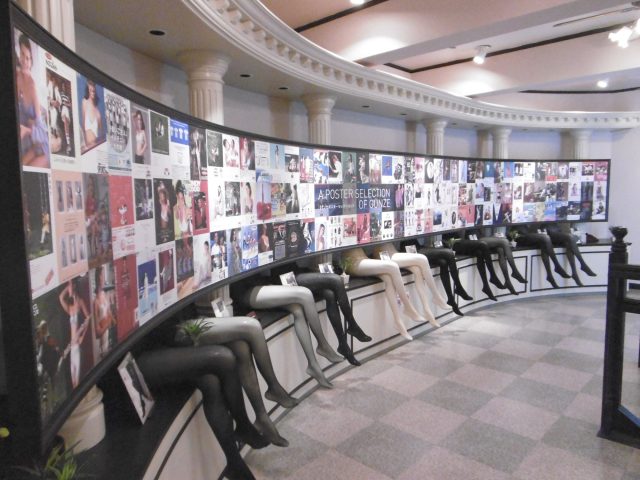
Exhibition Room in Gendai-gura (Photo courtesy of Gunze)
Expanding into plastics and medical businesses
Looking at the numbers from 2021, the apparel business accounted for 46% of total sales, while plastics, medical, and other functional solutions accounted for 45% of the total sales. A major turning point in the functional solutions was the launch of the plastics business in 1962. At that time, the company saw the potential in the rapid growth of the petrochemical industry, especially plastic resins, and began manufacturing sock packaging films in-house. At the same time, functional films for various applications were studied. Mr. Takao, the head of the museum said, “Gunze has a culture of doing everything we can by ourselves. We had the basic technology for plastic film production because packaging was also manufactured in-house.” Although it started small, the bold shift to the plastics business quickly became the backbone of Gunze. In Gendai-gura, plastic film packages made in-house are displayed along with the products.
In Mirai-gura, samples of environmentally friendly exterior packaging of frozen foods that can withstand the rigors of transportation and medical products that improve quality of life are on display. Projection mapping, in which images of regenerative surgery for cuts and skin injuries are projected onto the palm of one’s hand, and the regenerative medicine experience corner are popular mechanisms for simulating cutting-edge medical care.
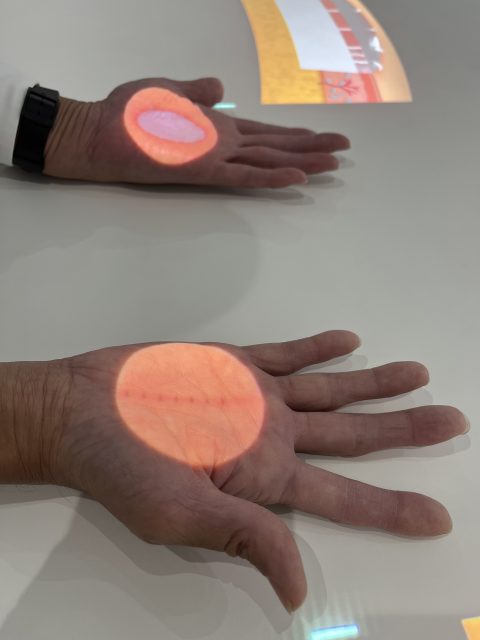
Projection mapping at the regenerative medicine experience corner (Photo taken by the author)
Creating a future society of co-creation
Tsurukichi left many words which are displayed throughout the museum. One of them is, “For the benefit of the world.” Focusing solely on the growth of the company is an individual burden. But when considering that, “through the growth of the company, you can contribute to the world,” that burden will be much easier to work with. These words express his expectations to employees to carry on that burden “for the benefit of the world.” Every year, an entrance ceremony for new Gunze employees working all over Japan is held in Ayabe, the birthplace of Gunze. The founder’s thoughts are presented and handed over by the president to the new employees who will be responsible for the future of Gunze.
Gunze Museum will continue to serve as an important base for disseminating information to more people about the legacy and life of Tsurukichi, who overcame many difficulties, and the corporate actions that “contribute to the world.”
